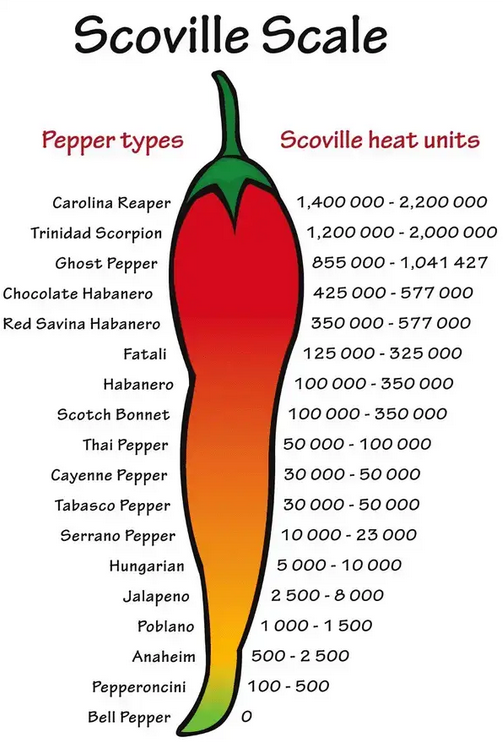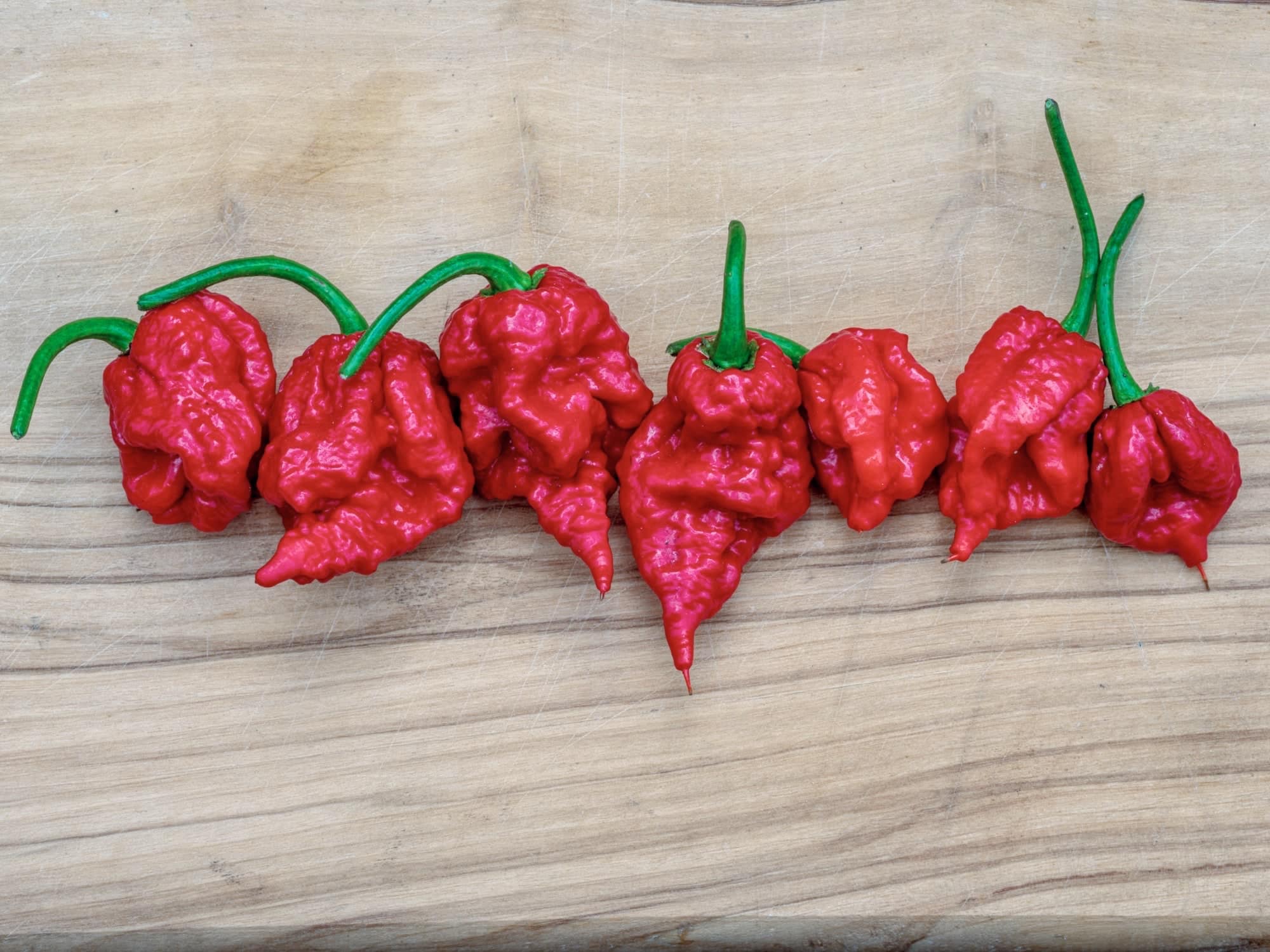Peppers, belonging to the Capsicum genus, owe their spiciness to a chemical compound known as capsaicin. Found predominantly in the pith and seeds of the pepper, capsaicin stimulates specific receptors in our mouths and tongues called TRPV1 receptors. When activated, these receptors send signals to our brain that we perceive as a burning sensation. The more capsaicin a pepper contains, the spicier it is considered. This spicy trait has evolved as a defense mechanism for the pepper plant against herbivores and fungi.
The Scoville Scale is like the “hotness meter” for peppers. It measures the spiciness or heat of a pepper based on its capsaicin content. So, brace yourself if you’ve got a pepper with a high Scoville rating – it will be a fiery ride! The higher the number, the hotter the pepper.
What is the Hottest Pepper on the Scoville Scale?
The Carolina Reaper is the hottest pepper, from 1,400,000 to 2,200,000 SHU. It holds the Guinness title as the world’s spiciest pepper, peaking at 2.2 million Scoville Heat Units (SHU). In contrast, a jalapeño hits 2,500-8,000 SHU, while cayenne scores 30,000-50,000 SHU.

There’s a certain allure to extreme experiences. Just as thrill-seekers chase the highest mountains to climb or the fastest roller coasters to ride, culinary adventurers search for the spiciest foods to ignite their taste buds. At the zenith of this heat-seeking journey, one finds the Carolina Reaper – the uncontested heavyweight champion of spicy peppers.
Below is presented Carolina Reaper hot chili pepper:

Origins and Breeding: A Fiery Endeavor
The Carolina Reaper’s journey to global acclaim began in Rock Hill, South Carolina, where Ed Currie of the PuckerButt Pepper Company meticulously crossbred a Pakistani Naga pepper with a Red Habanero. His mission? To create the world’s spiciest pepper. The Carolina Reaper was born after several iterations and years of careful cultivation.
Scoville Heat Units: Understanding the Scale
The Scoville Scale, developed in 1912 by Wilbur Scoville, measures the spiciness of chili peppers. It quantifies the amount of capsaicin present – the chemical responsible for that burning sensation. While a typical jalapeño pepper measures between 2,500 and 8,000 SHU, the Carolina Reaper averages around 1.6 million SHU, with peaks reaching 2.2 million.
Carolina Reaper nutrition facts
Nutrition Facts: Carolina Reaper (Per 100 grams)
- Calories: 40
- Total Fat: 0.4g
- Saturated Fat: 0.1g
- Trans Fat: 0g
- Cholesterol: 0mg
- Sodium: 6mg
- Total Carbohydrates: 8.6g
- Dietary Fiber: 3.7g
- Sugars: 5.2g
- Protein: 1.5g
- Vitamin A: 580 IU (12% DV)
- Vitamin C: 21.6mg (36% DV)
- Calcium: 14mg (1% DV)
- Iron: 0.5mg (3% DV)
Other Notable Compounds:
- Capsaicin: Responsible for the heat. Amounts can vary but are incredibly high in the Carolina Reaper.
- Antioxidants: Like other peppers, Carolina Reapers contain antioxidants, which help combat oxidative stress in the body.
- Bioflavonoids: These can contribute to cardiovascular health and may play a role in reducing inflammation.
Health Benefits:
- Capsaicin Benefits: This compound, found abundantly in Carolina Reapers, has been linked to pain relief and improved metabolism and may even have potential anti-cancer properties.
- Digestive Health: Some studies suggest capsaicin may help digestion by promoting stomach health.
- Heart Health: Capsaicin may help reduce cardiovascular disease risk by improving blood vessel functions.
Remember, these nutritional values are approximate, and the actual nutritional content can vary based on cultivation practices, soil health, and more. Always consume Carolina Reapers with caution, given their intense heat.
Cultivate Carolina Reaper
Growing the Carolina Reaper, or any super-hot chili, is both a challenge and a thrill for gardening enthusiasts. Here’s a detailed guide on how one can rise (cultivate) the Carolina Reaper:
1. Starting from Seeds:
- Seed Procurement: Buy Carolina Reaper seeds from a reputable source to ensure authenticity.
- Germination: Start seeds indoors 8-10 weeks before the last expected frost. Plant seeds in a sterile seed-starting mix about 1/4-inch deep. Cover them lightly with soil.
- Temperature: Keep the soil temperature between 75°F and 85°F. Using a heat mat can help maintain this.
- Moisture: Keep the soil consistently moist but not soggy.
2. Transplanting:
- Once the seedlings have at least two sets of true leaves and outdoor temperatures are consistently above 60°F at night, they’re ready to transplant.
- Harden off plants by gradually exposing them to outdoor conditions over a week.
- Transplant to a sunny location in well-draining soil. Space them about 1.5 to 2 feet apart.
3. Soil and Fertilizing:
- Carolina Reapers prefer slightly acidic to neutral soil (pH 6.2 to 7.0).
- Amend the soil with compost for good drainage and nutrition.
- When transplanting, fertilize with a balanced, all-purpose fertilizer. Later, as the plant matures and starts setting fruits, switch to a low-nitrogen, high-phosphorus fertilizer.
4. Watering:
- Water regularly, but allow the soil to dry out between watering. Overwatering can stunt growth and reduce fruit production.
5. Care and Maintenance:
- Pruning: When the plant is about a foot tall, trim a couple of inches off the top to encourage bushier growth.
- Pest Control: Watch out for aphids, spider mites, and whiteflies. Natural predators or insecticidal soaps can help manage these pests.
- Support: Some plants might need staking to support the weight as they grow and produce heavy pods.
6. Harvesting:
- Reapers typically take about 90 days from transplanting to harvest.
- The peppers will turn from green to bright red when ripe. Always wear gloves when handling super-hot peppers!
7. Overwintering (for perennial growing zones):
- If you’re in a zone where frost is minimal or non-existent, you can overwinter the plant. As temperatures drop, prune back the plant and reduce watering. It will go semi-dormant and bounce back in spring.
A Cautionary Note: Always handle Carolina Reaper with care. The oils can burn the skin and eyes. Wear gloves and wash hands thoroughly after handling.
A Dance with the Reaper: Tasting the Heat
The Carolina Reaper’s initial taste is sweet, almost deceivingly so. But within moments, an intense heat begins its crescendo, flooding the senses with a fiery burn that lingers. The experience is not for the faint-hearted; it’s a genuine test of one’s spice tolerance. Yet, many describe it as euphoric, with the body releasing endorphins as a natural response to the extreme heat, creating a unique “chili high.”
Health Implications: More than Just Heat
Beyond its fiery reputation, the Carolina Reaper has notable health benefits. Capsaicin, the very compound that causes the sensation of heat, has been linked to pain relief, decreased inflammation, and even potential cancer-fighting properties.
However, moderation is key. Overconsumption can lead to severe discomfort, from burning sensations in the mouth and stomach to more serious complications if one isn’t cautious.
Conclusion: The Reaper’s Fiery Reign
The Carolina Reaper’s reputation precedes it, embodying the pinnacle of culinary heat. It is a testament to human ingenuity and our never-ending quest to push boundaries. While it’s not a pepper for everyday consumption, it holds a special place in the pantheon of spicy foods – a valid symbol of extremity in the world of flavor.
- How Many Tablespoons is One Clove of Garlic? - June 26, 2024
- How to Measure 3/4 Cup When You Don’t Have the Right Measuring Cup? - June 6, 2024
- How Much Does Cooked Pasta Weight Compare To Dry? - April 30, 2024
